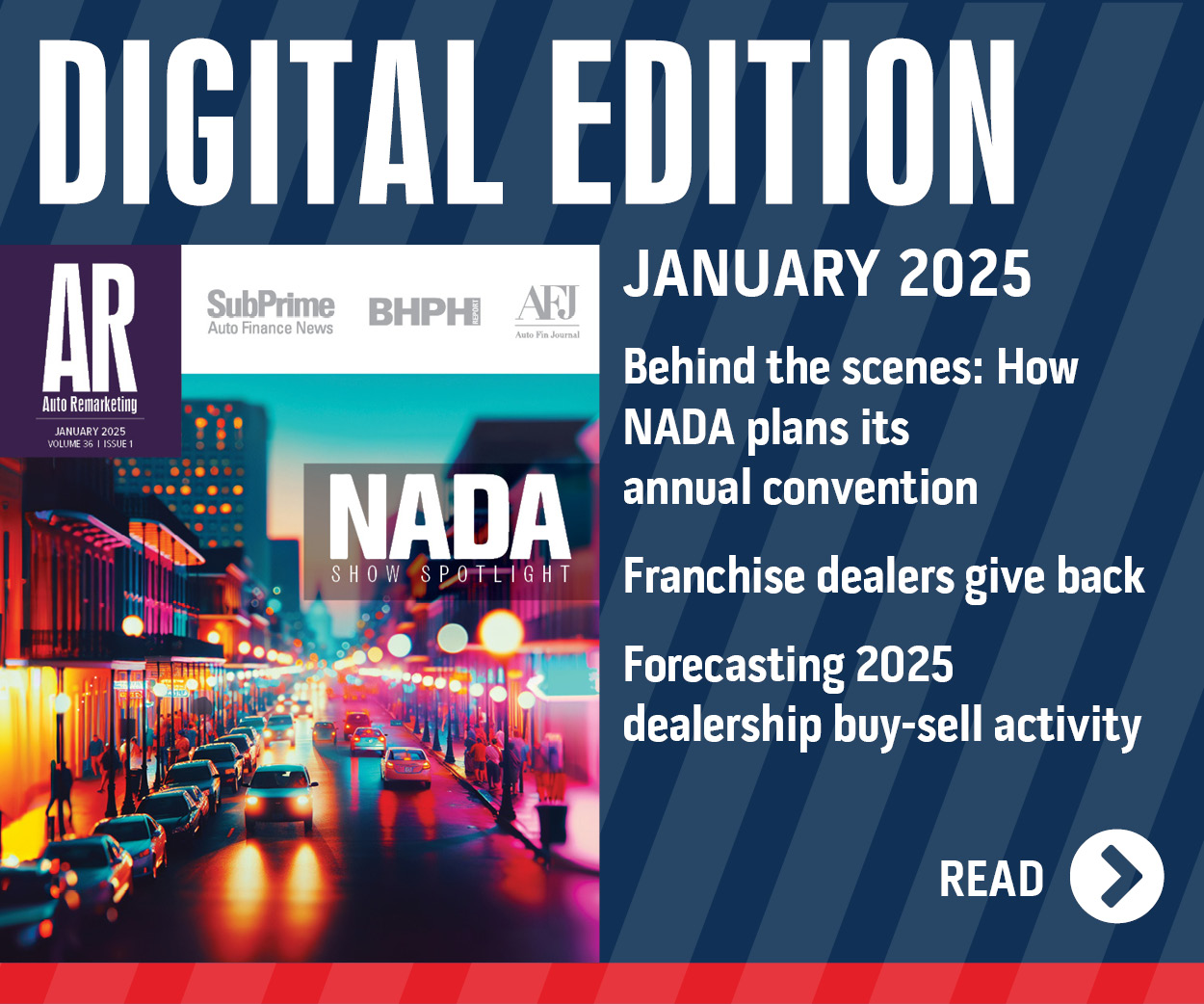Weary Dealers Could Finally See Relief from Rising Gas Prices, Tight Fuel-Efficient Inventory

Maybe only in 2008 have used-car managers faced so many inventory challenges at the same time — spiking fuel costs and wholesale prices creating major headaches about how to find units that will turn.
Some welcomed relief might be ahead soon according to NADA Used Car Guide. Edmunds.com agreed but not before giving a blunt assessment about what the current dealership climate is in relation to moving used models.
“Used cars for dealers now are not as profitable,” Richard Arca, pricing manager at Edmunds.com, told Auto Remarketing Wednesday.
Arca elaborated about how two crucial dealership variables are tightening tremendously — wholesale supply especially of compact models and used-vehicle retail margins as prices climb more toward new-vehicle levels.
Financial data from the National Automobile Dealers Association back up Arca’s assertion. March figures show gross profit as a percentage of a used-vehicle’s price slid from 14.23 percent down to 12.96 percent year-over-year. That drop left dealers getting $2.149 in gross profit per used unit in March, down from $2,222 a year earlier.
Arca also mentioned how lot managers are asking themselves the same questions repeatedly. Are gas prices ever going to fall back? Is that compact sedan worth the extra $1,000 at auction to get it on the front line?
“Dealers are in a situation where there is a scarcity of clean used vehicles, especially in the compact segment that are very hard to come by,” Arca stated.
“At auction, dealers are in a very competitive bidding environment," he went on to share with Auto Remarketing. "There are so many dealers who want that 2009 Toyota Corolla or 2010 Honda Civic. They’re going to pay maybe $1,000 more than they would like to pay because the demand is there for highly efficient vehicles. It’s hot right now.”
Then what if gas prices slip by as much as 50 cents per gallon? That decline would drop it well below that $4 threshold many economists and industry analysts believe to be the tipping point to what kind of vehicle consumers might want.
“There’s still this knee-jerk reaction to gas prices being at $4 a gallon. We’re still in that compact vehicle frenzy,” Arca surmised.
“When dealers acquire vehicles either at auction or through trade-in, they’re trying to look 60 days or 90 days out,” he continued. “If a dealer was to take in a vehicle now, it being May, they’re trying to forecast what the market is going to be like all the way into August. That may be a tough thing to do with the economy and gas prices.
“I’m not so sure the public has accepted the fact that gas is $4 gallon and may be that way for a while,” Arca stated. “Until the public accepts or gets used to those prices, the compact segment is still going to be pretty hot.”
For Dealers who can’t find fuel-efficient models in the lanes at a price they’re willing to pay, Arca acknowledged managers have no choice but to go to the trade-in route to have a selection of these models. He offered a scenario stores likely are utilizing.
“People that have compact vehicles and wanting to upgrade to a larger vehicle, say their life has changed considerably,” Arca offered. “You got married and had a couple kids and now you can’t fit everything you need in that compact vehicle. You might need a minivan. Now is the perfect time to upgrade to that minivan or SUV.”
So are compact vehicles going to be the units selling predominantly, regardless of whether they are new or used? Maybe not, Arca says.
“I remember back in 2008, $4 a gallon was really off the charts,” he recollected. “The public was crying over $3.50 a gallon. But then in 2009 and 2010 when gas was still well over $3 a gallon, the public got used to those prices and came back to popular SUVs. It’s really just a matter of time before the larger segments come back into play.”
NADA Used Car Guide Weighs in With Latest Projections
NADA UCG’s wholesale breakdown gave dealers a glimpse of some welcomed news ahead — especially in relation to the fuel-efficient segment.
Last month, analysts stated that through June they would see wholesale prices for compact vehicles increase by approximately 10 percent over March levels due to climbing fuel prices and tightening new-vehicle inventory stemming from the Japan disasters.
Given a slight decline in expected gas prices over the next several months, NADA UCG revised its segment forecast.
In addition to the increases observed between March and April, the firm anticipates that prices will increase by approximately 3 percent to 5 percent through June relative to April levels.
Analysts also expect prices for the midsize car and compact CUV segments to increase by 3 percent over April levels.
“Even though used prices for compact and midsize cars are to the point of historic highs, we believe that the pace of new-car price growth (by way of MSRP increases and incentive reductions) will be sufficient enough for a reasonable new-used spread to be maintained,” executive automotive analysts Jonathan Banks explained.
“New retail price growth for certain compact and midsize models can already be observed through April’s data with increases outpacing 2010’s results over the same period of time,” he continued.
Banks highlighted data from J.D. Power & Associates that mentioned a 3.7-percent increase for the Toyota Prius and 2.5-percent uptick for the Civic.
Turning over to truck segments, NADA UCG reiterated that there is significantly lower supply relative to 2008 and that condition will help keep prices from falling off precipitously — even in the face of $4 gasoline.
“So far, this has been the case and a continued decline in used supply will help to counter any additional increases in the cost of fuel,” Banks noticed. “In fact, our returning supply forecast has large pickup and SUV supply declining by 16 percent and 22 percent respectively through the third quarter on a year-over-year basis
“Taking these factors into consideration, we expect prices for the large pickup and SUV segments to be relatively stable through June,” he added.
From an Official Used Car Guide perspective, the firm said valuations for May’s edition are well positioned to reflect the “continued strength expected of the used market, with guidebook values generally positive to flat when compared to April figures.”
NADA UCG anticipates more strength in small and midsize car segments while expecting the impact from fuel prices on truck and SUV models to remain relatively minor since forecasted gas price increases might subside.
“Auction prices collected during the first two weeks of May have shown relatively small movements compared to the past two months,” Banks shared. “When coupled with the apparent slowdown in oil prices, we should see less volatile behavior on a segment basis going forward.
“As we move through May and into June, it’s our expectation that fuel price pressure will level off and wane somewhat, however inventory will become more of a concern,” he went on to say. “The expected result is another wave of price increases on high-demand models as fuel-efficient vehicles continue to be hard to come by.
“We expect this imbalance to continue through the summer which will further support prices at the historically high levels witnessed during April,” Banks added.
Dealers Go Online for Creative Ways to Boost Inventory
If the scenario Arca from Edmunds.com described doesn’t play out well for a dealer, Jeff Perkins, a senior manager at AutoTrader.com, highlighted a way his dealer clients are bringing decent trade-ins to the rooftop.
“In the current environment, it’s challenging for all dealers to get inventory, either through trade-in or at auction,” Perkins conceded. This will continue as all the industry feels the impact of the Japan crisis. This is an industry-wide problem. Eventually, OEM inventory will ramp back up.
“But for the short term, used car inventory will be challenging for dealers to acquire,” Perkins continued. “One AutoTrader.com tool that can help dealers acquire more inventory is the AutoTrader.com Trade-In Marketplace. This gives shoppers an instant offer for their car that they can redeem at a participating dealer.
“Dealers struggling with their inventory should consider trying this tool,” he suggested.
And Perkins went on to highlight how dealers need to mesh all of the tools they have available to help turn that dwindling gross profit on used-vehicles back in a positive direction.
“Some of our most successful dealers see AutoTrader.com as an extension of their overall marketing program,” Perkins stated. “These dealers have an integrated approach to marketing.
“Consumers today are bombarded with advertising messages wherever they go. So, the best dealers are making sure their marketing message is consistent at every possible consumer touch point,” Perkins insisted. “So if a dealer is advertising a sales event on TV or in the newspaper, they will also promote that sales event on AutoTrader.com through display advertising, special offers and in the content of their individual vehicle listings.
“By having a consistent message across all of their advertising, dealers can maximize the impact of their marketing budget,” he added.
Buyers Still Want Used Models
Lastly, one other piece of uplifting news for used dealers came from Dataium’s latest Auto Shopper Intensity Index.
The overall April reading saw its first month-over-month decline since last October, but the used retail marketplace wasn’t the reason why.
“Recent increases in used-car prices have not slowed consumer interest in pre-owned vehicles as this segment’s index increased nearly 2 percent,” Dataium reported this week.
“This may be driven by rising gas prices as consumers look for lower monthly payments to offset increasing fuel cost,” the firm went on to note.

 View The Latest Edition
View The Latest Edition

